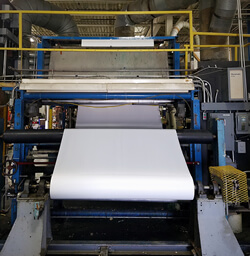10 Things to Know About Hot Melt Adhesive in Manufacturing

What Are Hot Melt Adhesives?
Hot melt adhesives are solid thermoplastic polymer adhesives. Notably, this material does not contain water or other liquids. They are made of multiple components that are bonded together. With proper hot melt technology, these adhesives are used to bond materials together. All hot melt adhesives contain three essential components to ensure a proper adhesive solution.
Polymers are the first component. Essentially, they are the key to hot melt adhesives’ ability to bond. Bond strength is crucial in the melting process. Moreover, they are also the reason that this material is flexible and strong. Finally, the polymers ensure durability.
Tackifying resins are the second component. The resins give the adhesive their wet feeling, which provides the bond between each substrate. Similarly, resins also determine the tack of hot melt. Tack refers to the stickiness of an adhesive.
Plasticizers are the third component. Plasticizers make application easy, by reducing viscosity. By reducing the thickness and fluidity of the adhesive, plasticizers ensure the heated product is malleable and aids in the melting process.
Other components found may include antioxidants and waxes. Antioxidants help to prevent degradation of the adhesive, while not in use. Additionally, antioxidants help to protect the integrity of the substance once you heat the adhesive to a molten state.
Waxes control how fast the adhesive (glue) sets. They also play a role in the open time. The open time refers to how long it takes for adhesion to occur and form a bond.
Before heating, hot melt adhesives are solid when at room temperature. When they are in their solid-state, they come in forms such as:
- Beads
- Blocks
- Chips
- Micro-chips
- Pillows
- Pellets
- Sticks
Once you apply a high temperature along with application and then let the adhesive cool to room temperature, a strong bond is created.
Based in West Unity, Ohio, Conversion Technologies International (CTI) can help with your hot melt adhesive coatings and laminations. Our state-of-the-art facility hosts the most innovative machinery and equipment available. Past and current clients include household names and global brands. We are happy to provide free consultations.
Understanding Polymers
Polymers are giant molecules also known as macromolecules. They are formed by linking simpler molecules together. This linking is known as polymerization. Polymers are used in millions of products. Phones, auto parts, water bottles, grocery bags, toys, and fibers all have polymers. Common polymers used in hot melt adhesives include:
- Ethylene n-butyl acrylate (EnBA)
- Ethylene-methyl acrylate (EMA)
- Ethylene-vinyl acetate (EVA)
- Polyamides
- Polyesters
- Polyethylene
- Polyolefins
Viscosity in Adhesives
Viscosity matters greatly when it comes to adhesives. Some products require low viscosity adhesives. Low viscosity adhesives flow easily. They are thin and liquid-like in nature. They have a low polymer content. Other products require high viscosity, resulting in a thick, gel-like adhesive to ensure the best adhesion. These adhesives have a high polymer content.
Hot Melt Defining Characteristics
Hot melt adhesives are not all the same. Different hot melts will have different characteristics. These defining characteristics include molten colors, peel, failure temperature, softening point, and thermal stability.
Molten color refers to the color of the adhesive. Peel refers to the amount of force you would need to break the bond, created by a hot melt adhesive. Failure temperature is the temperature that will cause the hot melt to stop working. The softening point is the temperature at which the glue begins softening from a solid to a molten liquid. Thermal stability refers to how well hot melt adhesive will stand up under different temperatures.
Benefits of Hot Melt Adhesives
In their solid-state, before application of a high temperature to bring them to their melting point, this material offers benefits including:
- Affordability
- Environmentally friendly (solvent-free)
- Long shelf life
- No special storage required
When warmed to their softening temperature, they become a molten liquid. Once they reach their melting point and reach this molten state, you can easily manipulate them which offers benefits such as:
- Application efficiency
- Bonds to countless surfaces and substrates
- Fast-acting
- Rapid-set time
Once they have cooled, they offer advantages such as:
- Flexible bonds
- Strong seals
- Lasting durability
- Moisture resistance
What are the methods and techniques to create a bond?
Some of the most versatile bonding agents available, one can use hot melts in everyday products that you probably never realized.
The first step to create a bond involves heat. First, you must heat the glue to a specific temperature. At this temperature, the solid adhesive melts into a molten liquid. Then, you can use it to bond a substrate with another substrate. More specifically, hot melt technology can bond limitless substrates together.
There are a variety of application methods to bind adhesives to surfaces of substrates. For instance, there are machines that spray them on a surface. Or, machinery can roll them out onto a surface. As a contract and toll manufacturer, CTI provides full-service adhesive coating. Our specialized equipment provides unmatched diversity and capabilities.
CTI employs multiple processing techniques. This means that we can create a custom system for coating your materials, to meet your adhesion requirements. Our facility is also equipped to handle adhesive thickness of 60 mil, roll weights up to 2,000 lbs., widths up to 120 inches. We can also manage cure temperatures up to 350° F.
If you have any questions for your project, contact us today. CTI is available to partner with you as a contract manufacturer before you begin a project. We are also able to step in, after your production process has begun, to help streamline the process. Partnering with CTI may help improve your ROI.
Options for Laminating
A large percentage of industrial hot melt adhesive products are used for laminating various materials together. Hot melt laminating adhesives can be used to bond countless materials, including but not limited to:
- Cardstock
- Cork
- Fabric
- Fiberglass
- Foam
- Foil
- Gypsum
- Hardboard
- Honeycomb
- Metal
- Padding
- Paperboard
- Plastic
- Rubber
- Vinyl
Industries that Use Hot Melt Adhesives
Polymer technology continues to advance, leading to an increase in a variety of hot melt adhesives across industries. Today, hot melts are even being custom-made for specific substrates. After all, they can bond together nearly everything. That’s why it’s become such a favorite of manufacturers. Some, but not all, of the industries using this material include:
Appliance Industry
The appliance industry routinely uses this material for insulation bonding, trim installation, and gasketing.
Auto Industry
Increasingly, the auto industry uses this material in products. Instances include seating, accessories, and trims of cars, SUVs, and trucks.
Electronics Industry
The flexible matter is also ideal for wire tacking, and small component assembly.
Filtration Products & Systems
Polymer hot melt adhesives are ideal for home, auto, medical, and commercial manufacturing filtration systems.
Packaging Industry
Various forms of packaging incorporate this substance as well. From bag sealing to carton sealing, the packaging industry relies on it.
Printing/Bookbinding
Polymer hot melt glues work well as bookbinders. Major book manufacturers and independent binders choose it for printing and binding.
Food & Beverage Industry
Durable and able to withstand temperature changes, they are ideal for food and beverage applications.
Furniture/Woodworking Industry
Hot melt adhesives allow for desired adhesion strength for mirrors, cabinets, office panels, and drawers.
Tapes/Mailing/Labeling Industry
This industry often requires customization and a range of tack levels. The diversity and flexibility of the process meets these needs.
Construction Industry
They are excellent choices for prefab wall construction, window sealing, and pallet fabrication.
Medical Industry
One also finds this substance in a variety of medical devices, and personal protection equipment.
Hot Melt Adhesives vs. Solvent-Based Adhesives
Non-volatile thermoplastic materials are the base of hot melt adhesives. They are ideal for simplified processing. Moreover, they contribute to streamlined manufacturing. They provide end-product protection, all the while being affordable, and better for the environment.
Furthermore, they do not require any special ventilation during the coating and laminating process. They are also often more affordable than solvent-based adhesives. Plus, they may also be less expensive.
A mixture of ingredients dissolved in a solvent form solvent-based adhesives. Examples of solvent-based adhesives include rubber cement and white glue. Solvent-based adhesives may need specialized ventilation, for the safety of workers.
Why Use a Contract Manufacturer for Hot Melt Adhesion?
A contract manufacturer, such as CTI can help you to save time and money. This can lead to a great ROI. Instead of improving existing products, or creating new products to handle manufacturing needs, consider partnering with CTI. CTI is available to partner with you at any point in the manufacturing process. CTI offers benefits such as:
- Sophisticated, innovative machinery
- Expert engineers and technicians
- R&D facility capable of testing prototypes, creating new products, and improving existing products
- Flexibility in manpower and production processes
- Access to our state of the art, modular facility
Best Choice for Hot Melt Lamination and Adhesion Needs
Based in Ohio, since 1992, Conversion Technologies International has earned rave reviews. Our experience is what sets us above the rest. Adhesive coating is a complex niche, and we are proud of our ability to problem-solve and design custom-solutions. In doing so, we provide added capability and capacity for your operation.
For nearly 30 years, our team has worked to improve and perfect our adhesive coating and laminating offerings. We have partnerships with several adhesive organizations. Fortune 500, and global brands alike trust CTI with their laminating and coating needs.
When it comes to all coating, adhesion, and lamination needs, look to CTI as your partner. CTI offers:
- Hot melt spray coating
- Slot die coating
- Powder coating
- Roll coating
- Meyer rod coating
- Hot roll lamination
- Much More
At CTI, we have a long history of success in working with international brands including: Clorox, Kimberly Clark, Valspar, Firestone, Owens-Corning, DuPont, Ford and General Motors.
CTI also offers fully customizable slitting and die-cutting services. We maintain several flat-bed die cutters, so we can cut from sheet or rolled form.
We are proud to offer a free consultation. During this free consultation, we will confirm that our capabilities meet your needs. We will ask for the status of your production cycle, and evaluate the resources needed for completion. Likewise, we will offer our state-of-the-art facilities to you for testing techniques, products, and materials. Fortuitously, CTI also has the ability to produce samples during the process, and before the pilot trial run. This step-by-step process helps ensure that a partnership between your company and CTI is successful and stays on target.
Finally, CTI is proud to be a BBB Accredited business maintaining an A+ rating. We are accredited by many industry standards boards. These include the ASME-American Society of Mechanical Engineers, ASTM-American Society for Testing and Materials, and ISO-International Organization for Standardization. Today, contact us for a free consultation by calling 419-924-5566. Or, contact us online.
We look forwards to hearing from you!
- << < Previous Post
- 1
- 2
- ...
- 116
- ...
- 241
- 242 Next Post > >>

